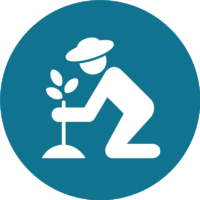Guiding Principles to Align Reforestation with Forest and Landscape Restoration
Brancalion, P. H., and R. L. Chazdon. 2017. Beyond hectares: four principles to guide reforestation in the context of tropical forest and landscape restoration. Restoration Ecology 25:491-496.
Forest and landscape restoration (FLR) has gained growing support in the policy arena as a means to combat some of the most pressing issues of our time: climate change, biodiversity loss, soil degradation, water insecurity, and rural poverty. Hundreds of millions of hectares have been pledged by governments globally to implement FLR, yet the main prerequisites of FLR works are not yet clear. What distinguishes a FLR program from a regular reforestation program? Can a poorly planned FLR program become a source of degradation, rather than restoration?
As an emerging field of activity, FLR advocates may not yet be concerned about principles because the main objective so far has been to attract support from the policy and investment sectors. Defining rules, principles, standards, or other ways to attach values to FLR may not be so well received by a community during the early stages of project initialization. Flexibility is critical, and adaptive management is imperative. However, trade-offs are also an inherent component of FLR, and decisions to reinforce one benefit of FLR could seriously undermine another benefit that is essential for achieving a multifunctional landscape. With these concerns in mind, we explored the literature, case studies, and our own experiences to address the thorny issue of proposing guiding principles in FLR.

A Eucalyptus plantation replaces native cerrado vegetation in Minas Gerais State, Brazil (photo by Robin Chazdon)
Our proposed guiding principles include: (1) restoration interventions should enhance and diversify local livelihoods; (2) afforestation should not replace native tropical grasslands or savanna ecosystems; (3) reforestation approaches should promote landscape heterogeneity and biological diversity; and (4) residual carbon stocks should be quantitatively and qualitatively distinguished from newly established carbon stocks. These principles may help decision makers to create strategies to engage indigenous and local communities in the process and consider their perceptions, interests, and limitations in FLR, to define no-go zones for reforestation, to select reforestation approaches, and to establish appropriate baselines in order to adequately quantify the benefits of a program.
We believe that these guiding principles can support higher transparency in program management and reliability for attracting investments of the private sector, which are important steps to unlocking the enormous potential of FLR to transform degraded and deforested landscapes and improve both biodiversity conservation and people’s lives.
The PARTNERS connection
This paper originated at the at the second PARTNERS workshop, when a group of researchers and NGO professionals discussed what kind of reforestation program could be considered a FLR program. It is an important concern because, in spite of the FLR commitments of hundreds of millions hectares, it was not clear how to monitoring the accomplishment of these commitments. A sub-group of PARTNERS members founded the Forest and Landscape Restoration Standard (FLoRES) task force, which was created to explore the significance of an FLR Standard, a set of benchmarks for motivating better outcomes and practices of forest landscape restoration. This paper was developed as part of the activities planned to achieve this overarching goal.




